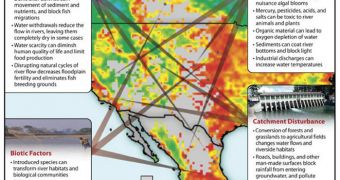The conclusions of a new scientific report show that rivers around the world are currently at great risk of being contaminated beyond repair; and the ecosystems they support may be destroyed as well.
There are currently an estimated 5 billion people living near or around rivers, and using them as the main source for drinking water, irrigation, factories, power plants and so on.
If anything were to happen with these bodies of water, than all the people depending on them for their very survival would need to find an alternative source of water, or they would simply die.
The recently-released document shows that most rivers in the world are now in crisis, and reveals that this disruption in their natural cycles may have dire implications for the people who depend on the running waters for their very existence.
Already, drinking water is in short supply around the globe, as is freshwater. This makes these two chemical the most essential natural resources in existence today.
As such, it would stand to reason that conservation efforts are undertaken to protect these fragile water sources, but that isn't happening. Rather the opposite, the document shows.
Humans keep exerting a large number of influences on rivers, such as for example diverting their courses for various purposes, using water for irrigation, constructing dams, building shoreline defenses and so on.
For the first time ever, the new study looks at how human practice has altered rivers through factors such chemical pollution, rising human populations and the global redistribution of invasive plants, fish and other animal species.
The team behind the new work created a map that allows researchers to determine the influence that various factors had on water quality and aquatic life throughout the Earth's rivers.
“We've integrated maps of 23 different stressors and merged them into a single index. In the past, policymakers and researchers have been plagued by dealing with one problem at a time,” explains Peter McIntyre.
He is a member of the team that conducted the new work, and he holds an appointment at the University of Wisconsin-Madison, Our Amazing Planet reports.
“A richer and more meaningful picture emerges when all threats are considered simultaneously,” says the expert. “Rivers around the world really are in a crisis state,” he goes on to say.
“What made our jaws drop is that some of the highest threat levels in the world are in the United States and Europe. Americans tend to think water pollution problems are pretty well under control, but we still face enormous challenges,” McIntyre adds.
Full details of the new work appear in the September 30 issue of the top-rated journal Nature.

 14 DAY TRIAL //
14 DAY TRIAL //